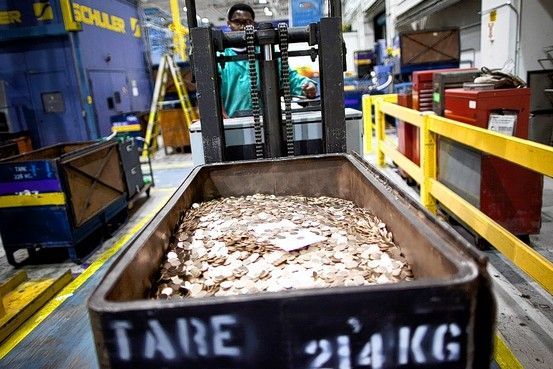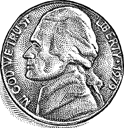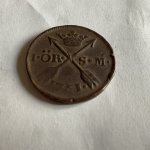West Jersey Detecting
Gold Member
Will Nickel-Free Nickels Make a Dime's Worth of Difference?

Will Nickel-Free Nickels Make a Dime's Worth of Difference?
Plan to Mint Cheaper Coins Tests Mettle of Laundromats, Zinc Lobbyists
By ELIZABETH WILLIAMSON
Wall Street Journal Monday, May 10 2010
 It costs the federal government up to nine cents to mint a nickel and almost two cents to make a penny. So, in addition to overhauling Big Finance, President Barack Obama wants to tinker with America's small change.
It costs the federal government up to nine cents to mint a nickel and almost two cents to make a penny. So, in addition to overhauling Big Finance, President Barack Obama wants to tinker with America's small change.
The president's plan to save money by making coins from cheaper stuff seems simple on its face. But history shows it would rekindle an emotional debate among Americans who fear changing the composition of their currency will hurt its value.
On top of that, trade groups from the coin-laundry owners to the Zinc Association have lobbied for years to keep small change just the way it is.
Like many things produced in Washington, U.S. coins aren't what they seem. A penny is a copper-coated token made mostly of zinc. The nickel contains more copper than it does actual nickel. And no coin contains silver anymore.
Market forces, not metal prices, determine the value of American currency. Yet Americans persist, on websites like coinflation.com, in tracking the value of the metal in their currency.
"People believe that we are still on some sort of precious-metal standard," says Rod Gillis, educator at the American Numismatic Association.
As the White House looks to cut costs across government, "making coins from more cost-effective materials could save more than $100 million a year, which isn't just pocket change," says Dan Tangherlini, the Treasury Department's chief financial officer.
The government isn't saying which new materials it might use in coins. Most coin experts say creating non-metal coins would go over like a wooden nickel. Still, industrial porcelain, embedded with an identification chip, is seen as an outside possibility. A more likely candidate: an aluminum alloy, used by other countries for coins. But any switch is likely to be controversial.
Already, Mr. Gillis spends a chunk of his day at the coin-collectors association taking calls from Americans worried that the Obama administration will confiscate their gold coins to prop up the economy.
He often asks people what gives a paper dollar its value. "Eight in 10 people make some sort of reference to the gold in Fort Knox," he says. But America has been off the gold standard since 1971, and gold currency stopped circulating in 1933.
No other stable nation has changed the metal content of its coinage less frequently. World War II shortages compelled the creation of a steel penny in 1943. The mint returned to copper after a year, even though that required smelting spent shell casings. The nickel's composition has gone unchanged since Thomas Jefferson's likeness was put on the coin in 1938, again with the exception of World War II, when for a brief period silver was added, because nickel was needed for weapons production.
In 1974, with copper prices soaring, President Richard Nixon suggested making the penny from lighter, cheaper aluminum. Machine vendors and most of the public were horrified. The plan fizzled when Mr. Nixon resigned that year.
In 1981, the Reagan administration proposed making the penny from zinc. The Copper and Brass Fabricators' Council sued, saying the plan would shackle the U.S. government to the whims of capricious foreign zinc miners. (Much of the zinc used in the U.S. comes from Canada.) It took the government two years to fully introduce the copper-plated, one-cent zinc piece.
So far, about 10 special interest groups say they're monitoring Mr. Obama's coinage proposal. "This needs more concerted action than the mint saying, 'Let's make it cheap,"' says Ute Wartenberg Kagan, executive director of the American Numismatic Society in New York.
A native of Germany, Ms. Kagan recalled Communist-era subway tokens and money made from plastic or from metals that rust. "Toy money," she says. "Is it worthy of a country like the U.S. to have coins of this nature?"
Laundromats and makers of vending machines and coin-counting machines are poised to weigh in, too. Their machines recognize the size, weight and alloy content of current U.S. coins, so any change could force costly retoolings or replacements.
"We're all taxpayers, and we're all in favor of being able to mint coins at a more reasonable cost," says Brian Wallace, president of the Coin Laundry Association. "But we want to make sure there aren't unintended consequences that could deeply impact the small-business owner during a recession."
Some groups say they fear cheaper coins could lead to a wave of counterfeiting. Convicted forger Frank Abagnale pooh-poohs that idea. "People would be more apt to counterfeit casino chips than American coins," says Mr. Abagnale, who advises governments and companies on how to avoid fraud and forgery. "I'm one of these people who would be in favor of doing away with the penny. I'm always in airports, and people just leave them all over the place."
Talk like that worries Americans for Common Cents, a group that has for years lobbied on behalf of the penny. "The penny is a hedge to inflation," says Mark Weller, executive director of the group, which is funded in part by the zinc industry. Without it, he argues, merchants would round up to the nearest nickel.
In 2006, when surging metal prices prompted Congress to consider eliminating the penny, the group released a study under the title, "Lincoln Penny Still America's Sweetheart Even Though It Doesn't Make Cents."
A least one group would support a sweeping change in the nation's coinage. Nickel, the most expensive and commonly used metal at the mint, is also the most allergy-producing metal in the world. According to the American Academy of Allergy, Asthma & Immunology, people allergic to nickel who have sustained contact with the metal—used in nickels, quarters and dimes—develop an itchy, poison-ivy-type reaction that can last up to a month.
"My husband always has these weird rashes on his leg from the change in his pocket," a treasury official involved in the coinage plans says. "Maybe he would benefit from a plastic quarter."
Write to Elizabeth Williamson at [email protected]

Will Nickel-Free Nickels Make a Dime's Worth of Difference?
Plan to Mint Cheaper Coins Tests Mettle of Laundromats, Zinc Lobbyists
By ELIZABETH WILLIAMSON
Wall Street Journal Monday, May 10 2010

The president's plan to save money by making coins from cheaper stuff seems simple on its face. But history shows it would rekindle an emotional debate among Americans who fear changing the composition of their currency will hurt its value.
On top of that, trade groups from the coin-laundry owners to the Zinc Association have lobbied for years to keep small change just the way it is.
Like many things produced in Washington, U.S. coins aren't what they seem. A penny is a copper-coated token made mostly of zinc. The nickel contains more copper than it does actual nickel. And no coin contains silver anymore.
Market forces, not metal prices, determine the value of American currency. Yet Americans persist, on websites like coinflation.com, in tracking the value of the metal in their currency.
"People believe that we are still on some sort of precious-metal standard," says Rod Gillis, educator at the American Numismatic Association.
As the White House looks to cut costs across government, "making coins from more cost-effective materials could save more than $100 million a year, which isn't just pocket change," says Dan Tangherlini, the Treasury Department's chief financial officer.
The government isn't saying which new materials it might use in coins. Most coin experts say creating non-metal coins would go over like a wooden nickel. Still, industrial porcelain, embedded with an identification chip, is seen as an outside possibility. A more likely candidate: an aluminum alloy, used by other countries for coins. But any switch is likely to be controversial.
Already, Mr. Gillis spends a chunk of his day at the coin-collectors association taking calls from Americans worried that the Obama administration will confiscate their gold coins to prop up the economy.
He often asks people what gives a paper dollar its value. "Eight in 10 people make some sort of reference to the gold in Fort Knox," he says. But America has been off the gold standard since 1971, and gold currency stopped circulating in 1933.
No other stable nation has changed the metal content of its coinage less frequently. World War II shortages compelled the creation of a steel penny in 1943. The mint returned to copper after a year, even though that required smelting spent shell casings. The nickel's composition has gone unchanged since Thomas Jefferson's likeness was put on the coin in 1938, again with the exception of World War II, when for a brief period silver was added, because nickel was needed for weapons production.
In 1974, with copper prices soaring, President Richard Nixon suggested making the penny from lighter, cheaper aluminum. Machine vendors and most of the public were horrified. The plan fizzled when Mr. Nixon resigned that year.
In 1981, the Reagan administration proposed making the penny from zinc. The Copper and Brass Fabricators' Council sued, saying the plan would shackle the U.S. government to the whims of capricious foreign zinc miners. (Much of the zinc used in the U.S. comes from Canada.) It took the government two years to fully introduce the copper-plated, one-cent zinc piece.
So far, about 10 special interest groups say they're monitoring Mr. Obama's coinage proposal. "This needs more concerted action than the mint saying, 'Let's make it cheap,"' says Ute Wartenberg Kagan, executive director of the American Numismatic Society in New York.
A native of Germany, Ms. Kagan recalled Communist-era subway tokens and money made from plastic or from metals that rust. "Toy money," she says. "Is it worthy of a country like the U.S. to have coins of this nature?"
Laundromats and makers of vending machines and coin-counting machines are poised to weigh in, too. Their machines recognize the size, weight and alloy content of current U.S. coins, so any change could force costly retoolings or replacements.
"We're all taxpayers, and we're all in favor of being able to mint coins at a more reasonable cost," says Brian Wallace, president of the Coin Laundry Association. "But we want to make sure there aren't unintended consequences that could deeply impact the small-business owner during a recession."
Some groups say they fear cheaper coins could lead to a wave of counterfeiting. Convicted forger Frank Abagnale pooh-poohs that idea. "People would be more apt to counterfeit casino chips than American coins," says Mr. Abagnale, who advises governments and companies on how to avoid fraud and forgery. "I'm one of these people who would be in favor of doing away with the penny. I'm always in airports, and people just leave them all over the place."
Talk like that worries Americans for Common Cents, a group that has for years lobbied on behalf of the penny. "The penny is a hedge to inflation," says Mark Weller, executive director of the group, which is funded in part by the zinc industry. Without it, he argues, merchants would round up to the nearest nickel.
In 2006, when surging metal prices prompted Congress to consider eliminating the penny, the group released a study under the title, "Lincoln Penny Still America's Sweetheart Even Though It Doesn't Make Cents."
A least one group would support a sweeping change in the nation's coinage. Nickel, the most expensive and commonly used metal at the mint, is also the most allergy-producing metal in the world. According to the American Academy of Allergy, Asthma & Immunology, people allergic to nickel who have sustained contact with the metal—used in nickels, quarters and dimes—develop an itchy, poison-ivy-type reaction that can last up to a month.
"My husband always has these weird rashes on his leg from the change in his pocket," a treasury official involved in the coinage plans says. "Maybe he would benefit from a plastic quarter."
Write to Elizabeth Williamson at [email protected]






